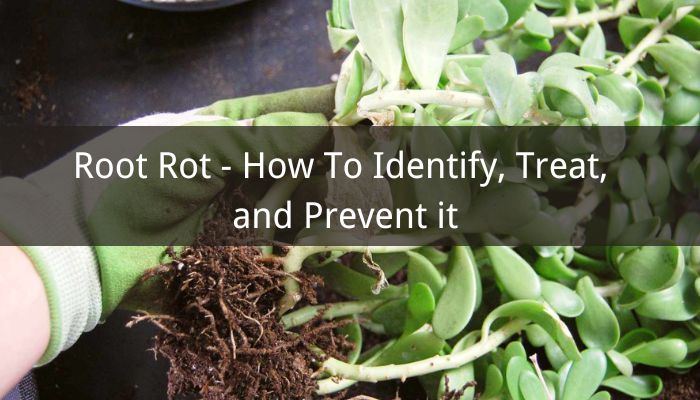
Root Rot - How To Identify, Treat, and Prevent it
If your plant has failed to recover from overwatering and has poor growth or dull, yellow, wilted leaves, it is highly likely that it is suffering from root rot.
It is a disease that typically affects the roots of plants that grow in wet or damp soil.
Root rot can affect almost all kinds of plants and trees and is experienced by amateurs as well as professional gardeners.
Can your precious plants be saved? How can you treat them? We'll answer these questions in this article so, keep reading.
In this article, we'll explore:
- Part 1: What Is Root Rot?
- Part 2: What Causes Root Rot?
- Part 3: Symptoms Of Root Rot In Plants
- Part 4: Treatment Approach For Root Rot
- Part 5: How To Prevent Root Rot In Your Garden
What is Root Rot?
Root rot, as the name suggests, is a condition where the roots of the plant begin to rot. This condition can occur regardless of whether you're growing indoors or outdoors.

Image Source: blog.leonandgeorge.com
However, it is much more common in indoor plants or houseplants, especially those that suffer from poor drainage as a consequence of overwatering. Because of the poor drainage and excess water, the roots don't get enough oxygen and begin to decay and rot.
This root rot disease can also be caused by the fungus in the soil which thrives in the wet and damp environment.
Since the initial symptoms of root rot occur beneath the surface of the soil, most people don't find out about the condition until it has severely affected the plant.
Root rot can stunt or stop the growth of the plant and cause it to die. This condition has similar symptoms to other diseases and infections, which is why it can be difficult (especially for beginners/amateurs) to figure out what is wrong with the plant.
If left untreated, root rot can spread to healthy roots. This is why it's important to take immediate action and treat the condition.
Root rot causes plants to have slow and stunted growth and it can immensely affect the overall quality and quantity of the crop.
In the next section, let's take a look at the causes of root rot.
What Causes Root Rot?
As discussed previously, root rot disease can be caused by poor drainage, overwatering, or even heavy rainfall — these factors cause the soil to become waterlogged.

The soggy, wet, and damp conditions prevent the roots from getting oxygen from the soil. As a result, the roots can't sustain the plant and start decaying and rotting.
Potted plants that are grown indoors under LED grow lights in a canopy might also be susceptible to root rot if the soil is not well-draining and aerated.
Full-spectrum LED grow lights aren't the root reason rot themselves — waterlogged roots, improper drainage, or overwatering are the real culprits. In a grow tent, LED grow lights are used as replacements for natural light. They can be used to grow your choice of plants all year round.
Additionally, root rot can be seen in hydroponic farming systems where the water is not aerated enough. Root rot tends to spread through the nutrient solution and can quickly spread to other plants.
One can notice this because of the slime-y appearance of the infected roots and the slightly rotten smell that comes from them.
In a plant canopy, indoor plants are grown in pots or containers. Sometimes, these containers don't have drainage holes or don't have enough of them (such as decorative ceramic planters or plastic containers) and thus, are prone to root rot.
Similarly, plants that are grown in dense potting soil with poor drainage might also require special attention.
This is not to say that outdoor plants aren't susceptible to root rot. By providing proper drainage to the plants, one can prevent root rot to a great extent.
It must be noted that excessive watering is not the problem in itself — the problem is that the wetness creates an ideal environment for fungus.

Fungi species such as Pythium, Armillaria mellea, Clitocybe tabescens, Phytophthora, Fusarium, and Rhizoctonia can also be responsible for root rot.
The fungus can come in contact with the roots through gardening equipment such as shears, pots, or shovels. It is also possible that dormant fungus present in soil thrives when it is exposed to the ideal environment.
Next, let's take a look at the root rot symptoms.
Symptoms Of Root Rot in Plants
Root rot has similar symptoms to pest infestation and other diseases, which can make it harder for gardeners to diagnose it. A few symptoms that you might notice are:
- Slow or stunted growth of the plant.
- Dull, pale leaves that are twisted or are smaller in size.
- Yellow, brown, and/or wilted leaves.
- Lots of leaves dropping off.
- Root rot causes the stems of the plant to become mushy.
- Gradually declining health of the plant. Growers will notice that the plant isn't recovering and is slowly dying, even after adjusting the water levels.
- Upon carefully uprooting the plant and inspecting the roots, growers would notice a stinking, rotten smell. The roots would typically have a different, unusual color and would be soft, spongy, and mushy. The roots would look brown and mushy instead of white and healthy.
Next, let's take a look at the treatment approach for root rot.
Treatment Approach For Root Rot
The treatment of root rot depends on the cause and how much it has affected the plant.
Upon inspection, if the growers find that the rot has spread through the entire root system, there are very few chances of the plant's survival.
However, if the plant still has some firm, white roots, it can be saved by removing the decaying roots and transplanting it to a new well-draining pot.

Image Source: Youtube
Here's how you can start treating root rot:
●Identifying root rot in the earlier stages is beneficial, as there are more chances that you would be able to save the infected crops. The first step of the treatment is careful inspection. To do this, uproot the plant and inspect the roots closely to understand their health status.
●One needs to be careful because root systems are pretty intricate and can be damaged if handled incorrectly.
●Gently clean the roots under running water and try to get rid of any soil that is attached to them. Chances are that the soil might be infected with fungus.
●Use clean shears or pruners to remove the infected roots. Fungal spores can be transferred through air, insects, and other organisms in the soil. Contaminated gardening equipment can facilitate the transfer of root rot spores.
●Infected roots look brown and mushy while healthy roots appear firm, white, and healthy. Make sure to not be lenient while trimming — root rot can spread easily if the roots are left attached, which is why it's extremely important to get rid of all the infected parts.
●Even if you're left with a small chunk of the root system, don't worry — get rid of a couple of leaves of the plant so that the roots can focus on regrowing the root system.
● To transplant the plant, it is recommended to throw away any leftover soil from the previous pot and replace the pot with one that has multiple holes at the bottom. Replace the soil with sterilized soil and make sure that you're working with clean and sanitized equipment.
●You can use rubbing alcohol or a bleach solution (nine parts of water with one part of bleach) to clean the gardening equipment and container.
●When repotting the plant, use a well-draining, aerated potting mix. Make sure that this mix is suitable for the variety of plants that you're growing.
●Generally, garden soil is quite dense and compact and doesn't pack enough nutrients for the plants. This is why it's important to use a potting mix that is specifically recommended for potted plants and contains lightweight components to improve drainage.
Finally, let's see how growers can prevent root rot disease in their gardens.
How To Prevent Root Rot in Your Garden
Find trusted stores to get your supplies
Buy your supplies such as nutrient solutions and soil from trusted stores to ensure that the soil does not contain fungal spores.
Opened bags of soil stay good for about six months or so. If these bags are exposed to air and moisture, the soil might become soggy/damp and have mold/mildew problems in the winter season.
Clean up the garden
Fallen leaves and debris can quickly accumulate on the surface of the soil. Before starting with a new batch of plants, ensure to thoroughly clean up the garden.
Make sure that you get rid of any dead plants at the end of the season since the fungus can feed on them and survive all through the winter season.
Go easy with the fertilizer
If your plant is recovering from root rot, make sure to use fertilizer carefully. An excessive amount of fertilizer can add too much salt to the soil.
Dip the roots in a fungicide solution
Before replanting the plant, growers can gently dip the healthy, firm roots in a fungicide for root rot to kill any remaining fungal spores. Some gardeners might even recommend the use of hydrogen peroxide to get rid of black root rot.
Rotating the crops
Gardeners can switch the placement of the crops each season to prevent root rot. This can be done by growing non-host plants until the pathogens present in the soil die.
Conclusion
Overwatering and poor drainage make it difficult for the roots to get the oxygen they require to sustain the plant. As the infected roots continue to decay and rot, they can infect healthy roots, even after you've made changes to the wet environmental conditions.
Dealing with root rot disease can be a pretty daunting experience. The best way to go about this is treating root rot as soon as you notice the symptoms and take all the necessary precautionary measures.
Related Posts
The Complete Guide To Grow Room Pest Control
Featured Products
Blog Posts
Contact Us with Any Idea!
- Choosing a selection results in a full page refresh.
!
































